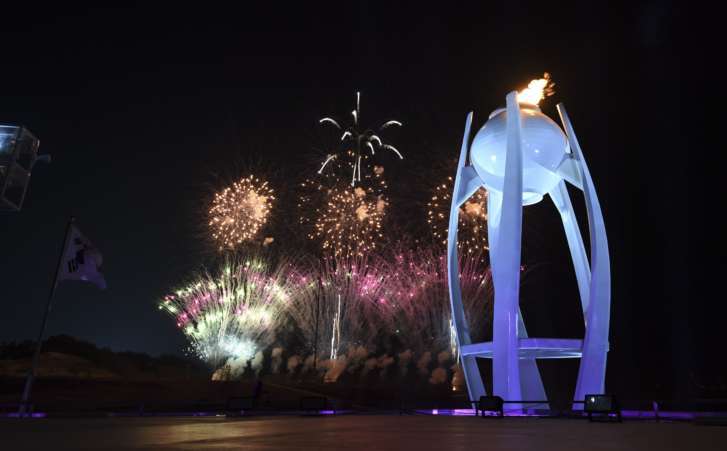Like for the torch, the shape of the main cauldron was inspired by the firebird. Close to the Fisht Stadium, in the heart of the Olympic Park, the flame burned for the Games' duration 50 m atop a tower which represented the head of the bird. At the base of the construction, its open wings formed a circle of about 100 m in diameter, where a fountain capable of producing a sound and light show and jets of water 60 m high could be found.

The 2016 Summer Olympics cauldron (Portuguese: Pira Olímpica Rio 2016) was made for the 2016 Summer Olympics in Rio de Janeiro, Brazil. In fact, there were two cauldrons, one in the Maracanã Stadium for ceremonial use, and another on Rio's new waterfront Boulevard Olímpico, opposite the 19th-century Neoclassical Candelária Church, which was lit after the Opening Ceremony and remained alight throughout the Games.[1] They both featured small flame cauldrons backed by much larger kinetic sculptures created by the American artist Anthony Howe. The ceremonial version spans 40 feet (12 m) in diameter.
Howe, in his work, wished to "replicate the sun, using movement to mimic its pulsing energy and reflection of light." After the 2016 Summer Olympics the waterfront cauldron has remained in place as a reminder of the Games. [2]

The 2018 PyeongChang Winter Olympic cauldron took inspiration from the traditional Korean moon jar. [YONHAP]
2020

Dragon King?
https://www.tokyoweekender.com/2014/01/cauldron-from-1964-olympics-gains-a-new-life-in-tokyo-2020-stadium/
On 7 September, the flame landed on the island of Okinawa. The first runner was Isamu Miyagi, who carried the torch to the Okutakeyama Stadium, where a welcome ceremony was held. To make up the delay owing to a typhoon in Hong Kong, a part of the flame was sent to the Japanese mainland in Kagoshima on 9 September, while the Okinawa relay continued. On 11 September, the two flames were once again reunited in Fukuoka.
The flame crossed Japan by taking four different paths, leaving respectively for Kagoshima, Miyazaki, Chitose and Aomori. From Chitose, the flame travelled to the prefecture of Aomori, where the route split into two: one headed for the south towards the Sea of Japan, and the other also went southwards but on the Pacific Ocean side.
On 9 October in Tokyo, in the square outside the Imperial Palace, the four flames were reunited in one cauldron on the occasion of a ceremony.
On the following day, the final relay stage during which the route went from the Imperial Palace to the National Stadium, the flame was carried by five men and two women before being handed to the final runner, Yoshinori Sakai, at the Opening Ceremony. He climbed the 163 steps that led up to the cauldron and lit it exactly three hours and three seconds after noon.
The name "Ryūkyū" originates from Chinese writings.[1][2] The earliest references to "Ryūkyū" write the name as 琉虬 and 流求 (pinyin: Liúqiú; Jyutping: Lau4kau4) in the Chinese history Book of Sui in 607. It is a descriptive name, meaning "glazed horn-dragon".
The origin of the term "Okinawa" remains unclear, although "Okinawa" (Okinawan: Uchinaa) as a term was used in Okinawa. There was also a divine woman named "Uchinaa" in the book Omoro Sōshi, a compilation of ancient poems and songs from Okinawa Island. This suggests the presence of a divine place named Okinawa.

No comments:
Post a Comment